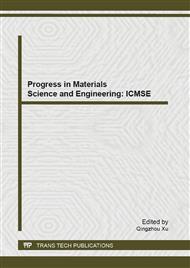p.279
p.287
p.293
p.299
p.305
p.312
p.317
p.321
p.325
Solid-Phase Synthesis of DNA Chemical Sensor
Abstract:
Oligonucleotides are essential components of many applications in molecular biology. The synthesis chemistry is robust and commercial oligonucleotide synthesizers have taken advantage of the chemistry to provide oligonucleotides of high quality and purity. This paper established nucleic acid synthesis platform to carry out the synthesis of the labeled nucleic acid probes based on the DNA synthesizer and solid-phase synthesis technology. We chose to study the automated synthesis starting from DMT protected FAM labeled amidite attached to controlled pore glass (CPG) support and the standard trityl-off oligonucleotide synthesis cycle was performed, yielding the solid-supported oligonucleotide. The reported automated solid-phase oligonucleotide synthesis procedure successfully employs the common iterative synthesis, deblocking, activation, coupling, capping, oxidation, and isolation steps in standard oligonucleotide synthesis. The automated synthetic approach can also be applied to oligonucleotides of different length, composition of nucleotide, demonstrating the universality of the method. Moreover, the synthesis involved the use of commercially available, safe, stable, and inexpensive reagents, particularly advantageous and attractive for their use in automated solid-phase synthesis. The synthesis allows custom tailoring of their structure to the requirements of biological assays within hours, as opposed to traditional approaches that require weeks or months of work in the laboratory. Therefore it will become much easier to investigate biological interactions and optimize for objectives such as the receptor mediated targeting of oligonucleotides.
Info:
Periodical:
Pages:
305-311
Citation:
Online since:
October 2013
Authors:
Keywords:
Price:
Сopyright:
© 2013 Trans Tech Publications Ltd. All Rights Reserved
Share:
Citation:


